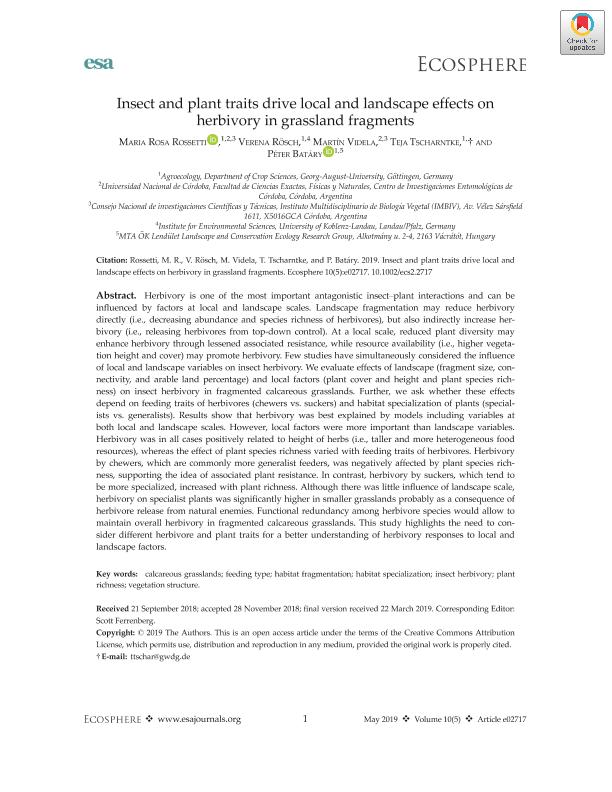Artículo
Insect and plant traits drive local and landscape effects on herbivory in grassland fragments
Fecha de publicación:
05/2019
Editorial:
Wiley-Blackwell
Revista:
Ecosphere
e-ISSN:
2150-8925
Idioma:
Inglés
Tipo de recurso:
Artículo publicado
Clasificación temática:
Resumen
Herbivory is one of the most important antagonistic insect-plant interactions and can be influenced by factors at local and landscape scales. Landscape fragmentation may reduce herbivory directly (i.e., decreasing abundance and species richness of herbivores), but also indirectly increase herbivory (i.e., releasing herbivores from top-down control). At a local scale, reduced plant diversity may enhance herbivory through lessened associated resistance, while resource availability (i.e., higher vegetation height and cover) may promote herbivory. Few studies have simultaneously considered the influence of local and landscape variables on insect herbivory. We evaluate effects of landscape (fragment size, connectivity, and arable land percentage) and local factors (plant cover and height and plant species richness) on insect herbivory in fragmented calcareous grasslands. Further, we ask whether these effects depend on feeding traits of herbivores (chewers vs. suckers) and habitat specialization of plants (specialists vs. generalists). Results show that herbivory was best explained by models including variables at both local and landscape scales. However, local factors were more important than landscape variables. Herbivory was in all cases positively related to height of herbs (i.e., taller and more heterogeneous food resources), whereas the effect of plant species richness varied with feeding traits of herbivores. Herbivory by chewers, which are commonly more generalist feeders, was negatively affected by plant species richness, supporting the idea of associated plant resistance. In contrast, herbivory by suckers, which tend to be more specialized, increased with plant richness. Although there was little influence of landscape scale, herbivory on specialist plants was significantly higher in smaller grasslands probably as a consequence of herbivore release from natural enemies. Functional redundancy among herbivore species would allow to maintain overall herbivory in fragmented calcareous grasslands. This study highlights the need to consider different herbivore and plant traits for a better understanding of herbivory responses to local and landscape factors.
Archivos asociados
Licencia
Identificadores
Colecciones
Articulos(IMBIV)
Articulos de INST.MULTIDISCIPL.DE BIOLOGIA VEGETAL (P)
Articulos de INST.MULTIDISCIPL.DE BIOLOGIA VEGETAL (P)
Citación
Rossetti, María Rosa; Rösch, Verena; Videla, Martin; Tscharntke, Teja; Batáry, Péter; Insect and plant traits drive local and landscape effects on herbivory in grassland fragments; Wiley-Blackwell; Ecosphere; 10; 5; 5-2019
Compartir
Altmétricas




